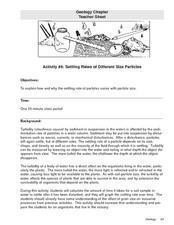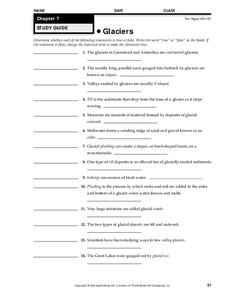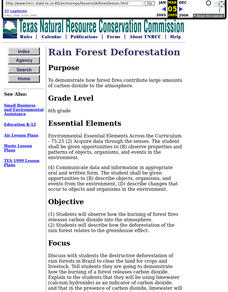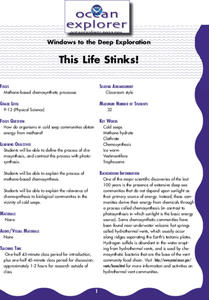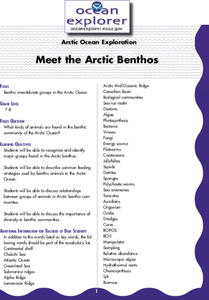Curated OER
Plotting the Petroleum Plume
Eighth graders examine the difference between confining layers and aquifers in a basic water table aquifer scenario. They contour groundwater elevation and petroleum product thickness data.
Curated OER
WHY WE AREN'T FILTER FEEDERS
Students describe three methods of obtaining food: scavenging, filter feeding, and hunting. They describe three methods of obtaining food: scavenging, filter feeding, hunting, and list at least two reasons why humans are not considered...
Curated OER
Riparian: The Guardian of the Waterways
Young scholars become educated on what a riparian is, the need for riparian, and how a riparian corridor (forest, habitat) can protect waterways. Students construct dioramas depicting riparian habitats.
Curated OER
Teaching Modeling Water Quality
Students explore the basics of interpreting RUSS temperature and oxygen profile data. They are introduced to the Geographic Information Systems (GIS), particularly with respect to interpreting maps.
Curated OER
Science Excursion: Cover Mapping Land
Young scholars study remotely sensed images and topographic maps to classify land cover types in their watershed area. They take samples in the watershed area to interpret the images.
Curated OER
Creating Journals
Students take a virtual tour of Yosemite and selects photographs to use in their journal.
Curated OER
Mud in the Water
Students build a soil erosion model to study the importance of soil conservation. They investigate how land forms from both constructive and destructive forces.
Curated OER
Settling Rates of Different Size Particles
Students discover how and why the settling rate of particles differs with the size of the particles. Using different soil samples, they calculate the amount of time it takes for a sample to settle in water for up to forty minutes. They...
Curated OER
Determine Soil Particle Size
Students examine various soil samples in groups. Using the samples, they identify the characteristics of them and calculate percolation and infiltration rates. They use this information to discover why some species can survive in one...
Curated OER
The Effects of Volcanoes
Students use the internet to research the effects of volcanoes. They create a chart showing the negative and positive aspects that a volcanoe can bring to an area. Using PowerPoint, they create a presentation showing the negative and...
Curated OER
Watersheds:Stream Channels And Post-fire Stream Flows
Students draw cross sections of a stream channel from field data. In the field, using a GPS, they determine the depth of a stream channel and use a spreadsheet to graph the stream channel.
Curated OER
Using Magnetotactic Bacteria to Study Natural Selection
High schoolers demonstrate that living organisms may possess incredible adaptations which enable them to survive. They observe bacteria that are able to orient themselves using the Earth's magnetic field and formulate a hypothesis as to...
Curated OER
Origin of Coal
Students explore how coal is formed. They then discuss the information and answer any questions that they may have on the formation of coal. Students then answer questions in reference to the coal discussion and reading.
Curated OER
Rocks Unit
Students learn about all types of rocks through a unit study consisting of 6 days. They are doing activities such as illustrating rocks, answering questions on a worksheet, reading, and reviewing questions. After the end of each...
Curated OER
Glaciers
In this glaciers worksheet, high schoolers review terms associated with glaciers including esker, till, plucking, and outwash. This worksheet has 14 true or false questions.
Curated OER
The Seafloor
In this seafloor instructional activity, students review the terms associated with formations found on the seafloor including sea mounts and seafloor spreading. This instructional activity has 8 fill in the blank questions.
Curated OER
Subsidence/ Erosion
Students utilize prior knowledge about the Pontchartrain Basin. In this subsidence/erosion instructional activity, students study the chart on land subsidence and must them identify and find solution for problems caused by erosion.
Curated OER
Chocolate Chip Cookie Mining Worksheet
In this coal mining math worksheet, students perform a set of operations to determine profit of mining a "chocolate chip cookie" and graph results.
Curated OER
Rain Forest Deforestation
Sixth graders explore the destructive deforestation of rain forests in Brazil to clear the land for crops and livestock. Students demonstrate how the burning of a forest releases carbon dioxide by performing an experiment.
Curated OER
Winds Over Land vs. Ocean
Students explore friction and the way it impacts wind over the ocean compared to over land.
Curated OER
This Life Stinks!
Young scholars explore the process of chemosynthesis and contrast this process with photosynthesis. They consider the relevance of chemosynthesis to biological communities in the vicinity of cold seeps.
Curated OER
Meet the Arctic Benthos
Learners recognize and identify major groups found in the Arctic benthos. They describe common feeding strategies used by benthic animals in the Arctic Ocean. They discuss relationships between
Curated OER
One Tough Worm
Pupils explain the process of chemosynthesis. They are able to explain the relevance of chemosynthesis to biological communities in the vicinity of cold seeps.
Curated OER
Cleansing, Sparkling Koos
Students explore the importance of water conservation and investigate how plants clean water.
Other popular searches
- Sedimentary Rocks
- Deposition of Sediment
- Sedimentary
- Sedimentary Rock Layers
- Edible Sedimentary Rocks
- Define Sedimentary Rocks
- Sedimentary Rocks Fossils
- Sedimentary Rock Formation
- All About Sedimentary Rocks
- Types of Sedimentary Rocks
- Sedimentary Rock Experiment
- Sedimentary Rocks Minerals









